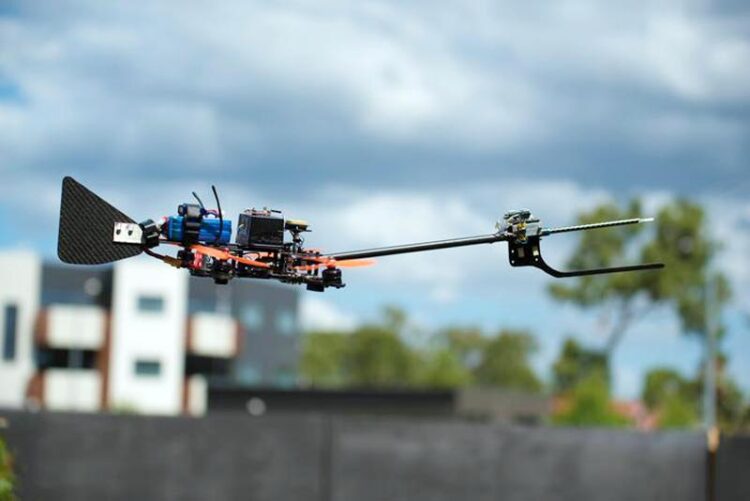City buildings could blow air taxi future off course

Drone used by RMIT University researchers to map wind flow around city buildings
Credit: RMIT University
The air taxi market is almost ready for take off, with companies such as Boeing, Hyundai, Airbus and Toyota building fleets to have commuters flitting through the sky. Europe and the US have both drafted new rules to pave the way for air taxis to begin operations within the decade, with Australia’s Civil Aviation Safety Authority (CASA) to follow suit.
Increasingly sophisticated studies over recent years, including a recent paper by RMIT University’s Uncrewed Aircraft Systems (UAS) Research Team, have measured how sudden wind gusts form around city buildings and destabilise aircraft.
Lead researcher and aerospace engineer, Dr Abdulghani Mohamed, who’s studied wind gust dynamics for over a decade, says this aspect needs to be adequately addressed by regulation in Australia and overseas before we fill our city skies with air taxis and other drones.
Strong wind gusts form around city buildings
Low-flying aircraft are at risk from wind gusts because they land and take off at low speed, explained Mohamed, with the RMIT research revealing sudden wind gusts can pose significant safety challenges for air taxis and drones in under a second.
As a result, air taxis and drones will need more power for landing or taking off in cities compared with an airport or an open space, he explained.
“These aircraft need powerful motors that can rapidly change the thrust generated by the propellers to rapidly force the vehicle back on-course, a process which requires more energy,” said Mohamed, from the School of Engineering.
Making our city skies safe
Regulations for Advanced Air Mobility (AAM) aircraft, such as future air taxis, are being compiled around the world, including the US and Europe. The RMIT team emphasises that weather frameworks are needed to ensure this new technology is safe and reliable.
“Regulations and certification need to specifically address safe operation when traversing building flow fields,” Mohamed said.
He argues that site-specific wind simulations and measurements are essential to identify hazardous regions.
“As we determine the location of vertiports – where these vehicles will take off and land – we also need to determine hazardous regions to avoid. This will enhance safety and reduce interruption of a fleet due to wind conditions,” Mohamed said.
“In Australia, it is not clear yet whether this falls under CASA’s jurisdiction or the Bureau of Meteorology, however, air taxis will need to be provided with weather information at much higher resolution and faster rates than currently possible. This is important for flight planning.
“The margin of error will be much lower than at airports, where large aircraft can tolerate much stronger gusts. We won’t have that flexibility with air taxis in cities.”
Next steps
“Purpose-built vertiports mean we could integrate geometric design features to reduce hazardous flow conditions from occurring, and we are exploring this in our current research,” Mohamed said.
“Existing buildings can also be repurposed as vertiports but may require modifications to improve the aerodynamics near the landing pads. The effectiveness of such design features can be assessed through either scaled experiments in wind tunnels or through full-scale measurements.
“Extensive wind flow mapping at full-scale will no longer be daunting in the future. We are continuing to develop our wind sensing drones – a swarm of drones instrumented with wind anemometers – to very accurately map around large infrastructure.”
‘Gusts Encountered by Flying Vehicles in Proximity to Buildings’ is published in MDPI’s Drones (DOI: 10.3390/drones7010022). The recommendations could help shape the regulation of vertiports, flight paths and air taxi requirements in Australia and potentially globally.
The researchers are continuing research into wind gusts around buildings, with further exploration of different building shapes that may minimise adverse effects. They are also continuing to study the sensitivity of vehicles to gusts and turbulence, as well as flight-stability technologies.
This research was conducted in collaboration with the University of Maryland and Lehigh University, and was funded by the US Airforce Office for Scientific Research and DSI Group.
Journal: Drones
DOI: 10.3390/drones7010022
Method of Research: Computational simulation/modeling
Subject of Research: Not applicable
Article Title: Gusts Encountered by Flying Vehicles in Proximity to Buildings
Article Publication Date: 31-May-2023
Media Contact
Sarah Gates
RMIT University
sarah.gates@rmit.edu.au
Original Source
All latest news from the category: Transportation and Logistics
This field deals with all spatial and time-related activities involved in bridging the gap between goods and people, including their restructuring. This begins with the supplier and follows each stage of the operational value chain to product delivery and concludes with product disposal and recycling.
innovations-report provides informative reports and articles on such topics as traffic telematics, toll collection, traffic management systems, route planning, high-speed rail (Transrapid), traffic infrastructures, air safety, transport technologies, transport logistics, production logistics and mobility.
Newest articles

Innovative 3D printed scaffolds offer new hope for bone healing
Researchers at the Institute for Bioengineering of Catalonia have developed novel 3D printed PLA-CaP scaffolds that promote blood vessel formation, ensuring better healing and regeneration of bone tissue. Bone is…

The surprising role of gut infection in Alzheimer’s disease
ASU- and Banner Alzheimer’s Institute-led study implicates link between a common virus and the disease, which travels from the gut to the brain and may be a target for antiviral…

Molecular gardening: New enzymes discovered for protein modification pruning
How deubiquitinases USP53 and USP54 cleave long polyubiquitin chains and how the former is linked to liver disease in children. Deubiquitinases (DUBs) are enzymes used by cells to trim protein…



